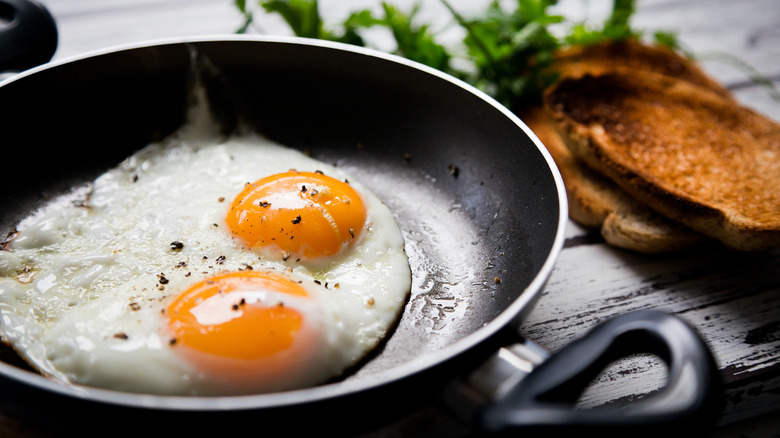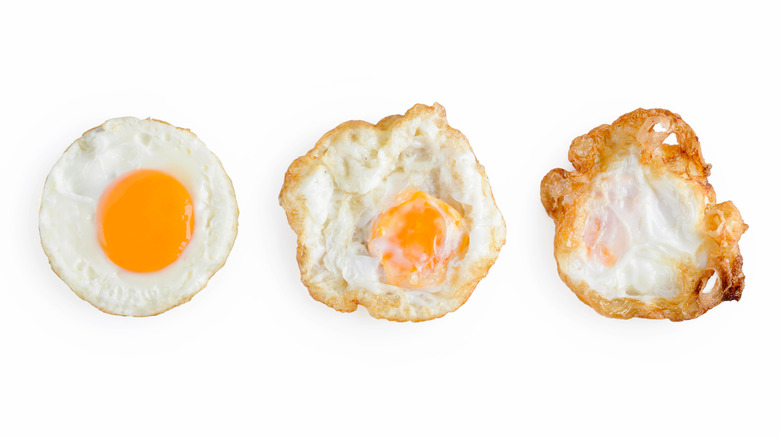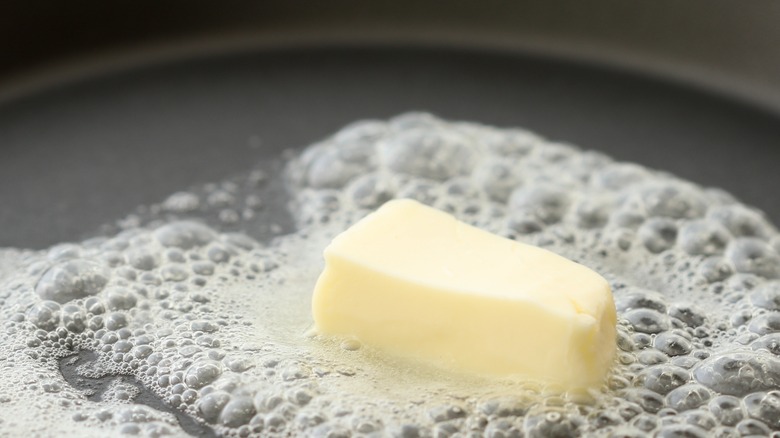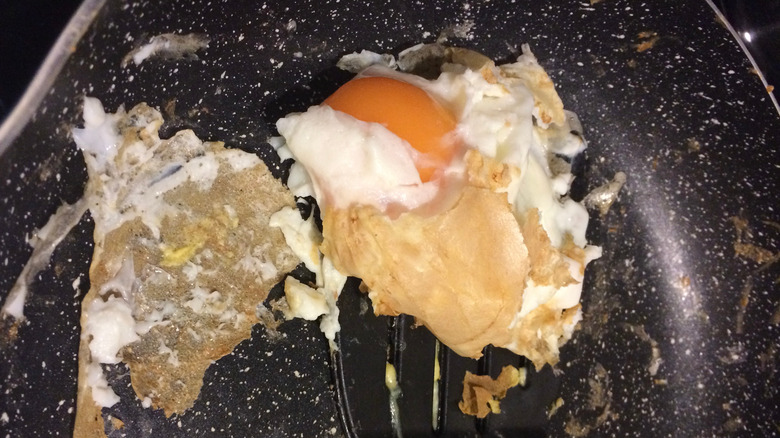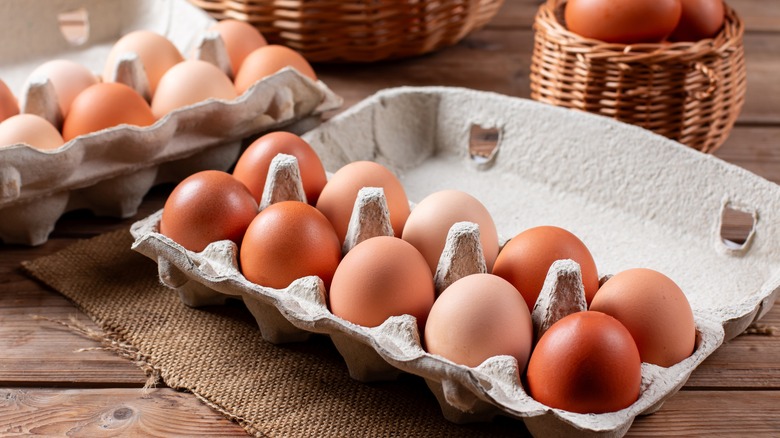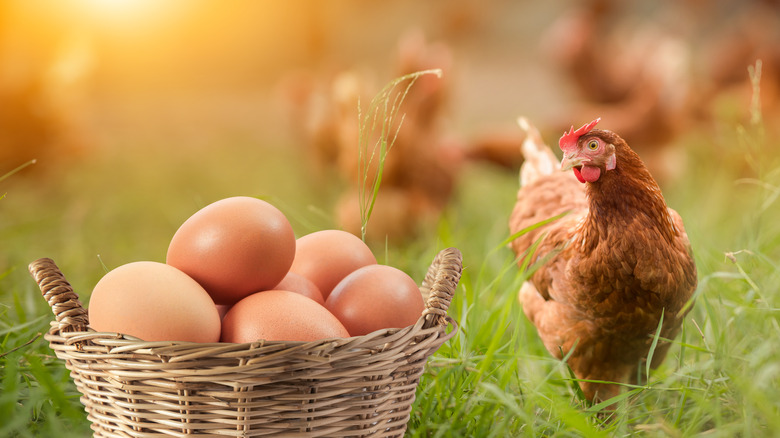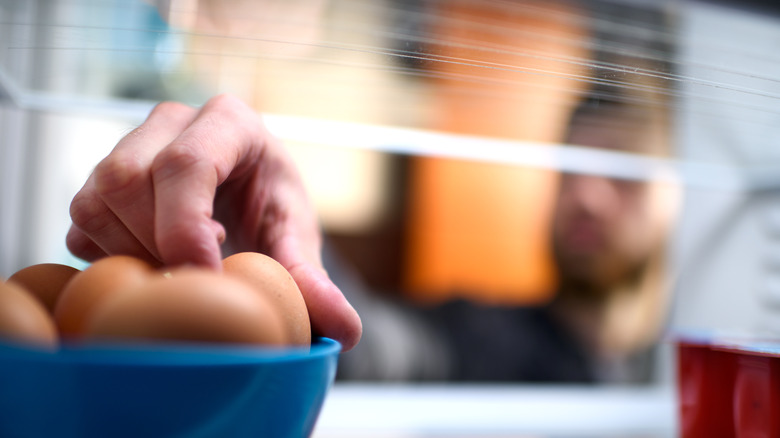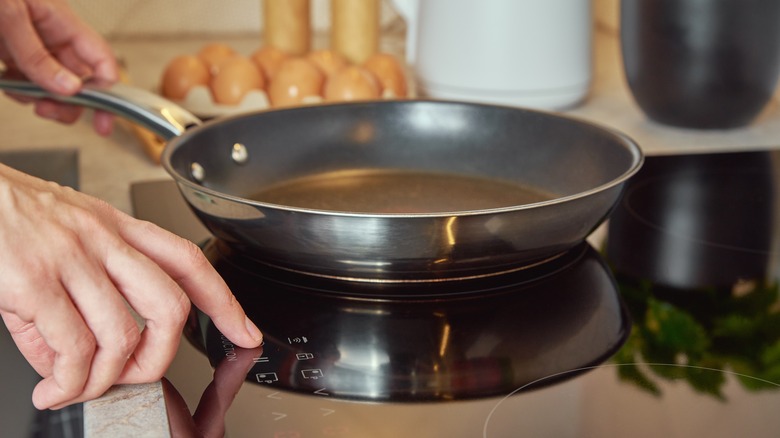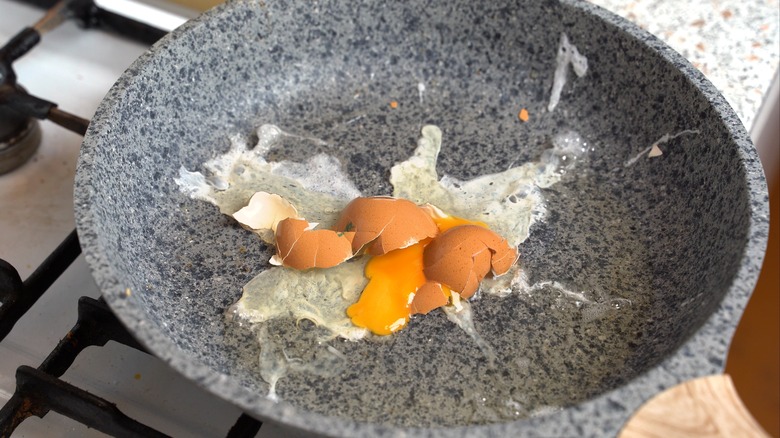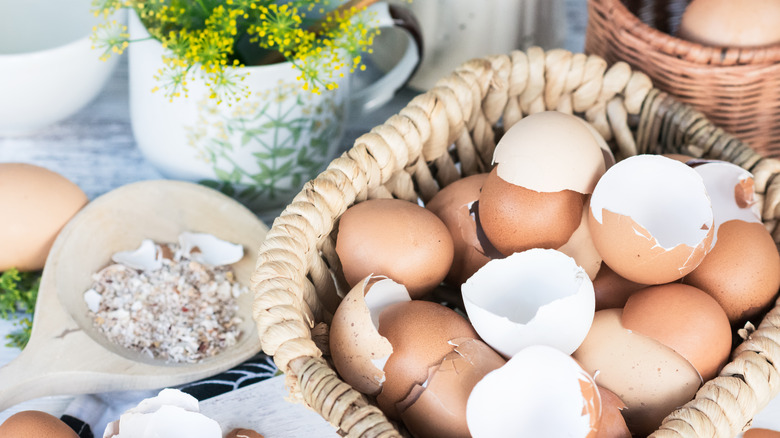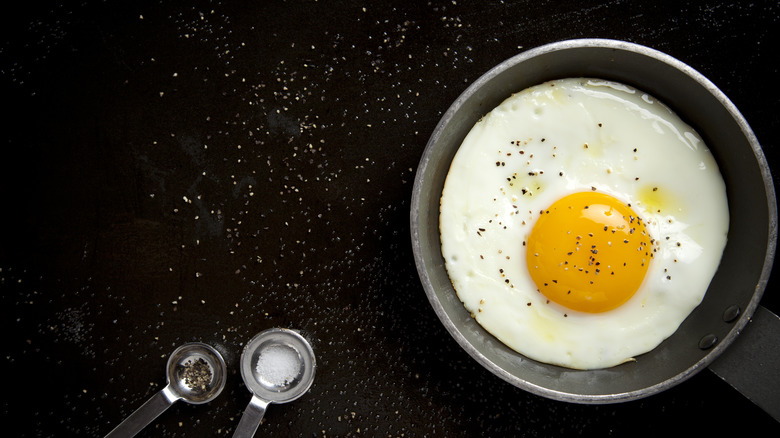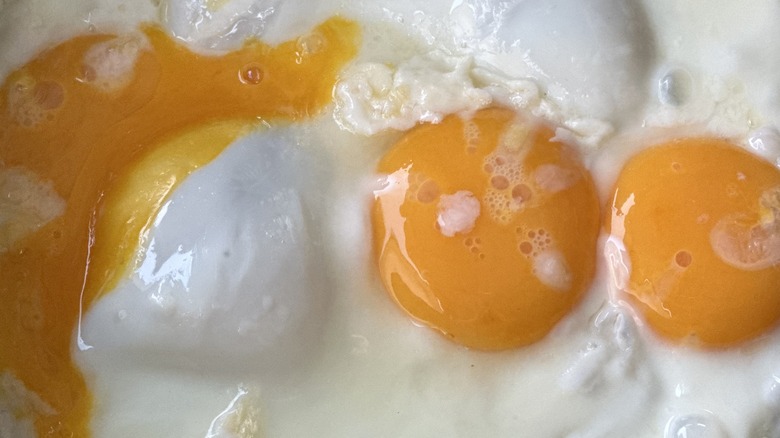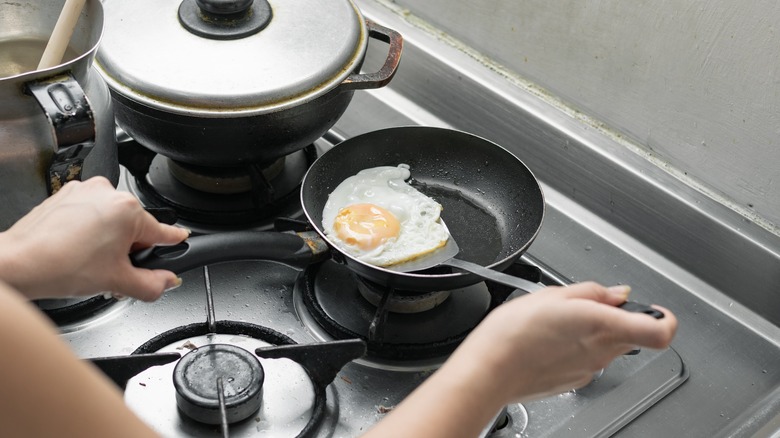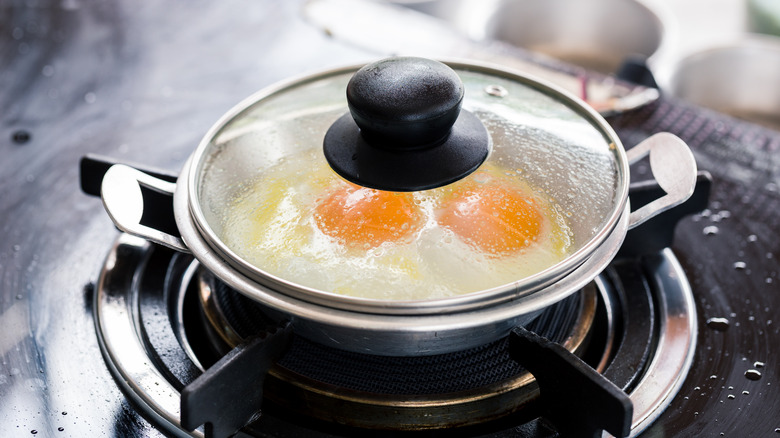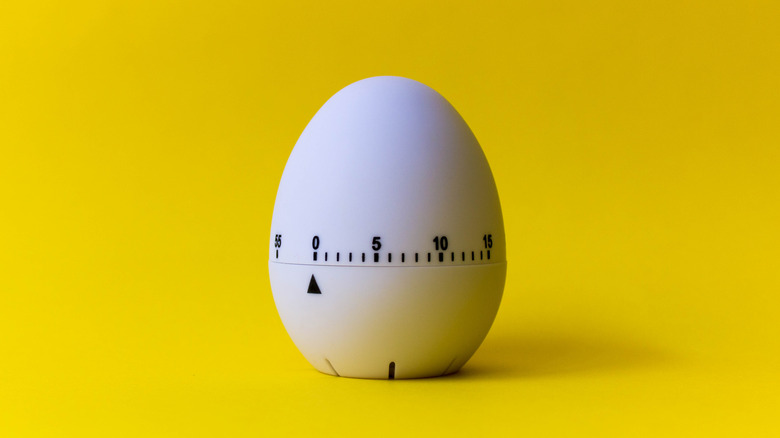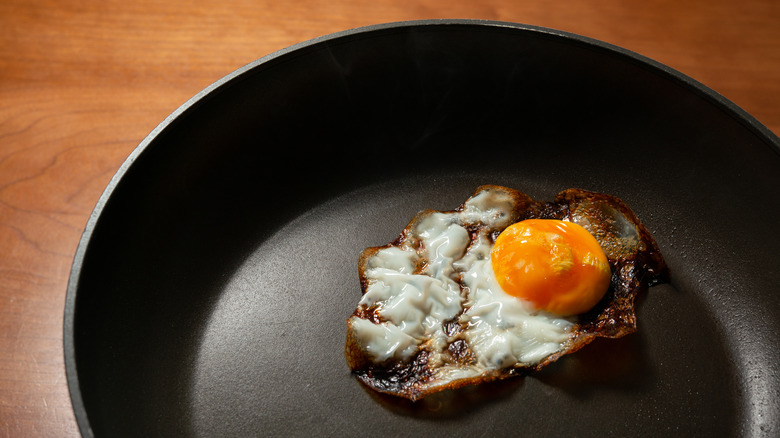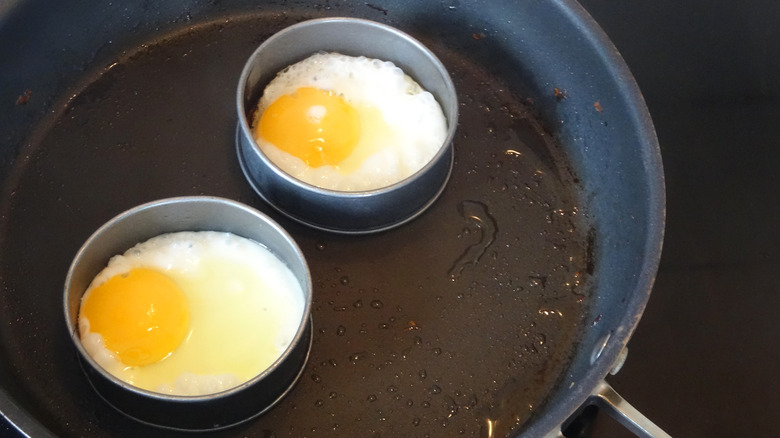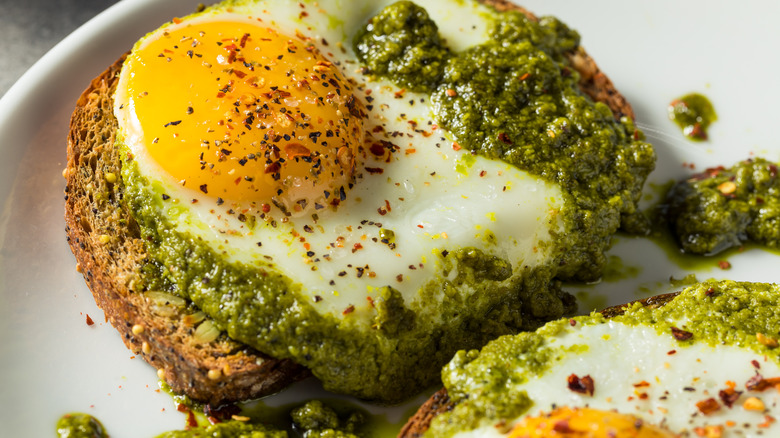17 Mistakes Everyone Makes When Cooking Fried Eggs, According To An Expert
There are few dishes as simple and satisfying as fried eggs. Not only are they extremely tasty and nutritious, but you'll find them in some form or another in a huge number of cuisines, offering dozens of ways you can enhance their flavor.
As an ex-restaurant manager who has run countless brunches and spent innumerable hours working in kitchens around the world, I've always felt that, despite their apparent simplicity, fried eggs can be somewhat difficult to master. Over the years, I've been fortunate enough to learn from extremely talented chefs, and I've paid close attention to their cooking tips, especially when it comes to making perfect fried eggs with the utmost efficiency. Below, I'm going to share the most common errors I've encountered when it comes to frying eggs. I've made these mistakes so you don't have to, and by the end of this guide you'll be well on your way to churning out professional-quality eggs every time.
Not knowing your fried egg styles
Before you can make restaurant-quality fried eggs, it's important to understand the differences between the various styles one can make. People's preferences vary, so you should know your sunny-side up from your over-easy.
Sunny-side up means only the bottom of the egg is cooked on the pan, so the white sets but the yolk remains liquid. Over-easy is where the egg is flipped part way through cooking, more thoroughly cooking the white but still leaving the yolk runny. Then, we have over-medium, which is similar to over-easy but the egg is cooked until the yolk is soft and jammy, followed by over-well when the egg is cooked until the yolk is solid. Lastly, we have over-hard, which is cooked to the same extent as over-well, but the yolk is broken and allowed to intermingle with the white as it cooks.
Picking the wrong fat
By definition, frying means cooking something in hot fat or oil, and you generally have two options to choose from: butter and oil. Of all the oils you can pick, olive oil is the best because it has a neutral taste that won't affect the dish, unlike a coconut or sesame oil, for example, which would alter the flavor of the eggs. That said, between butter and oil, which one is better for frying eggs?
Ultimately, it comes down to personal preference. While neither butter nor olive oil has an especially high smoke point, we don't need to fry eggs at the temperatures where that matters. If you prefer creamier, softer, and more buttery-tasting eggs then you'll want butter in your pan, preferably salted for extra flavor. If you like your eggs a little crispier, olive oil is the way to go. If you can't make up your mind, you can always use both by adding a small slab of butter to your oil and stirring them together until frothy, or by starting with olive oil and using butter to baste the eggs just before they finish cooking.
Using the wrong pan
Eggs are notoriously sticky when heated, so it's crucial to pick the right frying pan for cooking them. Using an unseasoned frying pan or one without a non-stick coating will cause your eggs to adhere to the base of it as they heat up, making it much harder to flip or remove them from the pan without them falling apart or burning in places.
There's a seemingly never-ending debate about whether well-seasoned cast iron or stainless steel pans are generally better for cooking than a non-stick pan, and all sides make good points. However, despite the benefits of using cast iron, most chefs I've worked with will concede that a non-stick pan is better for cooking most styles of eggs. When you're frying something as delicate as eggs and you have to be neat and efficient, there's a much lower risk of them breaking or burning with a non-stick pan, plus it's much easier to clean between uses.
Using low-quality eggs
It should go without saying that higher-quality eggs taste better and have improved nutritional values compared to lower-quality ones, but how can we tell the difference? There are so many different egg descriptions these days that you need an entire guide on how to make sense of the various labels on the cartons.
Ultimately, opting for organic, pasture-raised eggs should guarantee a good level of quality and provide some assurance that the egg-producing hens are treated humanely. From a taste perspective, hens that are given higher-quality feed tend to lay more flavorful eggs, and those that have space to roam and forage produce eggs with more nutrients and higher protein levels. While caged hen eggs may be cheaper, you'll be missing out on tastier, more nutritious eggs while relying on ethically dubious production methods. That being said, some egg labels that sound promising aren't backed by any real certifications and are often just marketing terms, so be sure to familiarize yourself with the different terminology.
Not using fresh eggs
When it comes to cooking with eggs, the fresher the better. The most obvious reason for choosing eggs that have been laid more recently is that they haven't had as much time to spoil; although, the smell and taste of rotten eggs should be enough of a warning sign before you start cooking with them.
When kept refrigerated, eggs can last between three to five weeks before they go bad, so the risk of encountering bad eggs is relatively low. If you're not sure whether the eggs you have are still fresh, you can test them by giving them a shake or by seeing whether they float in water, although these methods aren't perfect. Truthfully, the best way to guarantee freshness is simply by keeping track of when you purchased your eggs. It's also worth remembering that store-bought eggs will never be as fresh as those from a farm, but be aware that the "farm fresh" egg carton label is unregulated. If you're fortunate enough to live near a farm that supplies eggs and can afford the extra cost, it's great it you can pick them up yourself.
Using cold eggs
Depending on where you are in the world, it's possible that you store your eggs in the fridge. While eggs have no issues staying fresh without being refrigerated, this practice is usually recommended when they have been transported at low temperatures to maintain the cold chain and prevent temperature fluctuations inside the eggs.
Either way, if you do keep your eggs chilled, you should take them out of the fridge and let them come up to room temperature before frying. When you add chilled eggs to the pan, they'll bring the temperature down which will interfere with your cooking times. You also risk overcooking the yolk while the white reaches the right temperature, making it much harder to achieve perfect sunny-side up or over-easy fried eggs. Letting eggs reach room temperature can take a few hours, so if you don't have that much time on your hands, you can submerge them in warm water to speed things up.
Not preheating the frying pan
Before you start frying your eggs, it's crucial to let your frying pan reach the right temperature first. Starting off with a cold pan will increase your cooking times, potentially leading to undercooked eggs with raw sections that may pose a health risk.
We also need to make sure our butter or oil has enough time to reach the optimum temperature for frying. If the fat isn't hot enough, it won't melt enough to coat the whole base of the pan, and it won't be able to kick-start the Maillard reaction. In layman's terms, this is the chemical reaction between amino acids and reducing sugars that gives browned foods their tasty flavor and distinct color. First, you want to let your frying pan reach the right temperature, then add your fat — just be careful adding fat to a hot pan as it may spit and has the potential to burn you if it lands on bare skin.
Cracking the egg on the pan rim
Most of us are probably guilty of cracking our eggs on the edge of the frying pan before cooking them. It might be the quickest method but it's definitely not the best for achieving perfect fried eggs.
There are plenty of things that can go wrong when you crack your eggs on the pan. Firstly, I find it nearly impossible not to drip some of the egg white down the edge of the pan, no matter how many times I try. Not only is this wasteful but you can say goodbye to a picture-perfect fried egg. There's also the risk of breaking the yolk if you're overzealous in your cracking, and you're more likely to get pieces of shell in the pan. Instead, one at a time, crack an egg into a bowl or ramekin, then slowly and gently pour it into the hot pan to avoid making a mess.
Immediately throwing away the eggshell
Once you've released your delicious egg from its oval prison, you might be tempted to toss the shell straight away, and there's nothing wrong with keeping on top of your kitchen cleanliness. Yet, while you certainly can throw spent eggshells in the trash, you may want to keep hold of them a little longer so you don't miss out on their potential usefulness.
I'm yet to find a better way to remove stray pieces of broken eggshell from a frying pan than using a larger piece of the shell to scoop it out — it's quick, clean, and saves you having to stick your fingers too close to the heat, while other utensils tend to make more of a mess. So, if you are going to toss your shells, it's best to wait until after you've finished cooking. There are also many ways to use cracked eggshells instead of throwing them out, including using them to fertilize your plants, keep pests out of your yard, and help with cleaning and stain removal.
Forgetting the seasonings
Despite eggs' status as a staple food in a huge range of cuisines, it wouldn't be unfair to say their taste is somewhat underwhelming. When it comes to fried eggs, especially, most of the flavor comes from the buttery yolk and the fat in which they're cooked.
One of the benefits of fried eggs, however, is that their less potent flavoring means there are plenty of ways to customize your eating experience. The simplest way to do this is with seasonings that will improve the eggs' natural flavors or introduce interesting twists. At a minimum, you should add a pinch of salt and pepper to fried eggs to give them a little bit of spice, but why stop there? Personally, I find garlic and onion powder are excellent for adding a more savory, umami element to fried eggs in a way that isn't too intense and plays well with other foods you might be enjoying alongside them. If you're looking to enhance your eggs even further, a pinch of smoked paprika is perfect for introducing a mild heat and a unique but complementary flavor.
Moving the eggs around the pan
A common mistake people make when frying foods in a pan is moving things around unnecessarily. Of course, some recipes do call for this, but fried eggs are best left alone until it's time to flip.
The main issue is that it can take some time for the bottoms of the eggs to crisp up to the point they'll no longer stick to the base of the pan; moving them around before this happens means you're likely to break the yolk or white. On occasion, the egg white may not spread out as much as you'd like, but poking the egg with a spatula or spoon is not the best solution. Simply pick up the pan and gently swirl it until the egg whites have distributed more evenly. As long as you've used the right amount of fat and have your cooking temperatures on point, you shouldn't have to touch the eggs again unless you're turning them over.
Misjudging the flip
As I mentioned earlier, most fried egg styles — excluding sunny-side up — require you to flip the egg part way through in order to cook the top. However, this can be a delicate process, especially if you're trying to keep the yolk somewhat runny and intact.
First off, you're not going to be able to flip a fried egg without a utensil like you might a pancake, so you'll need the right tool for the job. You'll want to use a flat-bottomed spatula to avoid deforming the egg, or even a fish spatula that has a nicely angled edge and can slide easily under the egg. That said, if you're using a non-stick frying pan, you may want to choose a silicone spatula so as not to damage the non-stick coating. If you're using a cast iron or stainless steel frying pan, a metal utensil is absolutely fine.
Not knowing the pan lid trick
If you're a fan of sunny-side up eggs — they're my personal favorite style — then you might already know that they can be harder to get perfect than styles that involve flipping. Often, you might find that your yolk is in danger of cooking solid before the top of the egg white is done.
Fortunately, there's a simple trick to help the top of the egg white cook faster so you don't end up with a raw egg. Once the bottom of the egg has started to set, grab a saucepan lid that roughly fits over your frying pan and pop it on top, making sure it doesn't touch the egg. Heat and steam will get trapped inside and help cook the top of the egg more rapidly. If you need to speed things up, you can add a teaspoon of water to the pan to create more steam — just make sure you take off the lid before the yolk overcooks.
Getting the timings wrong
Eggs tend to cook pretty quickly, so it's important to know how long you have before it's time to take them out of the pan. If your chosen style of fried eggs requires flipping, you'll also need to know when it's time to turn them over.
For sunny-side up eggs, you should be able to judge doneness based on sight — the egg whites will no longer be translucent but the yolk will still be orange and glossy. For over-easy, wait until there's about ½ inch of uncooked whites around the yolk, flip the egg, then wait about 15 to 20 seconds to allow the rest of the white to cook. For over-medium, you'll want to flip your egg around the same time, but allow up to 45 seconds for the yolk to cook. With over-hard or over-well eggs, you can let the second side cook for up to 2 minutes until your desired level of doneness.
Not paying attention to cooking temperatures
You might hear varying opinions on whether eggs should be fried at lower or higher temperatures, but ultimately it comes down to how you like your eggs cooked. The more familiar you become with your cooking times, the easier it will be to adjust the temperature to your preference.
If you fry them on a low to medium heat, the eggs will take longer to cook but you'll end up with softer whites. If you use a higher heat, you'll end up with crispier whites but you'll want to reduce your cooking time, especially if you also want the yolk to remain a bit runny. It's also important to remember your fat — if you turn up the heat too much, you'll burn your butter or oil which will make your eggs taste burned, bitter, and acrid, and the fat may start to spit.
Blowing off cooking rings
While it may seem superfluous, getting your hands on some cooking rings is the secret to making perfectly uniform eggs every time. These are simply circular molds that contain your cracked eggs and help them keep their shape as they cook. These gadgets are especially handy if your fried eggs are destined to top a burger or breakfast sandwich.
Cooking rings come in various sizes, so the smaller the ring, the thicker your eggs will be. They also generally come in two materials: silicone or stainless steel. Silicone rings are essential for non-stick pans as they're less likely to damage the surface; plus they don't require greasing. Metal rings are the better choice for cast iron or stainless steel pans, but you'll need to rub the insides with a little butter or oil so the eggs don't stick when you remove them.
Slacking on the sauce
I've already covered the benefits of seasoning fried eggs, but you shouldn't stop there. You might be surprised just how many sauces and condiments out there will elevate your eggs.
Of course, there are the classics, such as tangy tomato ketchup and zingy sriracha, but it's worth exploring the sauces of other cuisines too. If you like spice, try North African harissa, Korean gochujang mayonnaise, or even Argentinian chimichurri. Or, for a mild and herbaceous flavor, try Italian pesto. To add a saltier, umami element to your eggs, soy sauce is a great option, or the fun-to-pronounce Worcestershire sauce. At the end of the day, the best way to discover new flavor combos is experimentation. The subtle flavor of fried eggs makes it hard to go wrong, and you can always take inspiration from other egg dishes, like trying out the hollandaise from eggs Benedict or the spicy tomato sauce from shakshuka.

